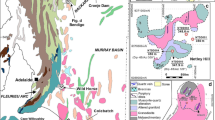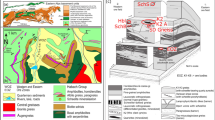Summary
The podiform chromitites investigated in the course of this study occur in intensely serpentinized dunites and peridotites of unknown age (paleozoic or older) within a metamorphic complex consisting of gneisses, amphibolites and marbles. Concentrations of platinum group elements (PGE) and the distribution of platinum group minerals (PGM) have been investigated in the chromitite occurrences of Dobromirci and Pletene.
PGE concentrations in chromitites vary from 787 to 891 ppb (Dobromirci). The highest value was recorded in chromite ore from Pletene (1274 ppb). The enrichment is due to high contents of Os, Ir and Ru, whereas the contents of Rh, Pt and Pd are relatively low. The Ru-contents (480-600 ppb) are remarkable and correspond to the average content in chondrite Cl. Chondrite-normalized PGE distribution patterns of chromitites of both localities reveal a distinctly negative trend from Ru to Pd, which is typical for chromites from ophiolites.
Irrespective of their chemical composition, most chromites carry numerous PGM inclusions which have formed during the magmatic stage at high sulphur fugacity (fs2). In addition to laurite, the main mineral, there are sulpharsenides of Ru-Ir-Os (ruarsite, irarsite, osarsite).
Textural aspects and the results of chemical analyses show that the concentration of PGE is not caused by substitution in the lattice of chromite, but by magmatic formation of discrete PGM before or contemporaneously with chromite. All PGM apparently remained unaltered. No evidence for remobilization or redistribution of PGE by serpentinization has been found.
Zusammenfassung
Die untersuchten podiformen Chromite tretey in stark serpentinisierten Duniten und Peridotiten unbekannten Alters (paläozoisch oder älter) innerhalb eines hochmetamorphen Komplexes auf, der aus Gneisen, Amphiboliten und Marmoren besteht. In den Chromitit-Vorkommen von Dobromirci und Pletene wurden Konzentrationen der Elemente der Platingruppe (PGE) und die Verteilung der Minerale der Platingruppe (PGM) untersucht.
Die PGE-Konzentration der Chromitite variiert zwischen 787 und 891 ppb (Dobromirci). Die höchste Konzentration wurde im Chromiterz aus Pletene (1274 ppb) gefunden. Die Anreicherung geht auf hohe Beteiligung von Os, Ir und Ru zurück, da die Gehalte an Rh, Pt und Pd relativ niedrig sind. Auffallend hoch sind die Ru-Gehalte (480-600 ppb), die dem mittleren Gehalt im Chondrit Cl entsprechen. Chondritnormalisierte PGE-Verteilungsmuster von Chromititen beider Lokalitäten zeigen einen stark negativen Trend von Ru zu Pd, der für Ophiolith-Chromite typisch ist.
Unabhängig von ihrem Chemismus führen die meisten Chromite zahlreiche PGME-Einschlüsse, die sich magmatisch bei hoher Schwefelfugazität (fS2) gebildet haben. Neben dem Hauptmineral Laurit, wurden Sulfarsenide von Ru-Ir-Os (Ruarsit, Irarsit, Osarsit) festgestellt.
Texturelle Merkmale der PGM und Ergebnisse der chemischen Analysen führen zu der Schlußfolgerung, daß die Konzentration der PGE nicht auf eine Substitution in Chromit, sondern auf die Frühbildung der selbständigen PGM vor oder gleichzeitig mit den Chromiten zurückzuführen ist. Die PGM zeigen keine Alterationserscheinungen. Es wurden keine Hinweise für eine Remobilisation oder Umsetzung der PGE durch Serpentinisierung gefunden.
Similar content being viewed by others
References
Augé T (1985) Platinum group mineral inclusions in ophiolitic chromite from the Vourinos complex, Greece. Can Mineral 23: 163–171
—— (1986) Platinum-group-mineral inclusions in chromitites from the Oman ophiolithe. Bull Minéral 109: 301–304
Barnes SJ, Naldrett AJ, Gorton MP (1985) The origin of the fractionation of platinum-group elements in terrestrial magmas. Chem Geol 53: 303–323
Constantinides CC, Kingston GA, Fischer PC (1979) The occurrence of platinum group minerals in the chromitites of the Kokkinorotsos chrome mine, Cyprus. In:Panayiotou A (ed) Proceedings of the International Ophiolithe Symposium Cyprus. Ministry of Agriculture and Natural Resources, Geological Survey Department, Cyprus, pp 93–101
Cousins CA, Vermaak CF (1976) The contribution of southern African ore deposits to the geochemistry of the platinum group metals. Econ Geol 71: 287–305
Economou MI (1985) Platinum group elements (PGE) in chromite and sulphide ores within the ultramafic zone of some Greek ophiolite complexes. In:Gallagher MJ et al (eds) Metallogeny of basic and ultrabasic rocks. Proceedings of the conference held in Edinburgh, Scotland, 9–12. April, 1985, pp 441–453
—Zhelyaskov-Panayotova M (1989) Platinum Group Elements and Gold in Chromite Ores within Rhodope Massif Ultramafic Rocks (Balkan Peninsula). 28th International Geological Congress, Washington, D.C., U.S.A., July 9–19, Abstr. Vol. 2, pp 1–433
Leblanc M, Fischer W (1990) Gold and Platinum Group Elements in Cobalt Arsenide Ores: Hydrothermal Concentration from a Serpentinite Source-Rock (Bou Azzer, Morocco). Mineral Petrol 42: 197–209
Legendre O (1982) Mineralogie et geochemie des platinoids dans les chromites ophiolithiques. Unpubl. Thesis. L'Universite Pierre et Marie Curie, Paris, 171 pp
McElduff B, Stumpfl EF (1990) Platinum-Group Minerals from the Troodos Ophiolite, Cyprus. Mineral Petrol, 42: 211–232
Naidenova E, Zhelyaskova-Panayotova M, Kudrjawceva GP, Laputina IP (1984) First discovery of laurite and irarsite from Bulgaria. Comptes rendus de l'Académie bulgare des Sciences, 37 2: 183–186 (in Bulg)
Nicolaev G (1958) Geology of the area of Village Benkovsun and Drangovo, region of the town Momchilgrad. Ann MGJ 2: 25–53 (in Bulg)
Nilsson LP (1990) Platinum-Group Mineral Inclusions in Chromitite from the Osthammeren Ultramaîic Tectonite Body, South Central Norway. Mineral Petrol 42: 249–263
Page NJ, Pallister JS, Brown MA, Smewing J, Haffty J (1982) Palladium, platinum, rhodium, iridium and ruthnium in chromite-rich rocks from the Samail ophiolite. Oman. Can Mineral 20: 537–548
——,Cassard D, Haffty J (1982) Palladium, platinum, rhodium, ruthenium and iridium in chromitites from the Massif du Sud and Tiebayhi Massive, New Caledonia. Econ Geol 77: 1571–1577
——,Engin T, Singer DA, Haffty J (1984) Distribution of platinum group elements in the Bati Kef chromite deposit, Guleman-Elazig area, Eastern Turkey. Econ Geol 79: 177–184
Pajakov JV, Zhelyaskova-Panayotova M, Ivchinova J (1963) Structure-texture features and minerals of chromite ores in the ore deposits Dobromirci. Ann Univ Sofia, BGG, fac, 56, 2: 219–251 (in Bulg)
Prichard HM, Tarkian M (1988) Platinum and palladium minerals from two PGE-rich localities in the Shetland ophiolite complex. Can Mineral 26: 979–990
Stockman HW, Hlava PF (1984) Platinum-group minerals in Alpine chromitites from southwestern Oregon. Econ Geol 79: 491–508
Tarkian M (1987) Compositional variations and reflectance of the common platinumgroup minerals. Mineral Petrol 36: 169–190
——,Prichard HM (1987) Irarsite-hollingworthite solid-solution series and other associated Ru-, Os-, Ir-, and Rh-bearing PGM's from the Shetland ophiolite complex. Mineral Deposita 22: 178–184
Thalhammer O, Stumpfl EF (1988) Platinum group minerals from Hochgrössen ultramafic massif, Styria: first reported occurrence of PGM in Austria. Trans IMM 97: B77–82
Thalhammer O, Prochaska W, Mühlhans H (1990) Solid inclusions in chrome-spinels and platinum group element concentrations from the Hochgrössen and Kraubath Ultramafic massifs (Austria). Contrib Mineral Petrol 105: 66–80
Vermaak CF, Hendricks LP (1976) A review of the mineralogy of the Merensky reef with specific reference to new data on the precious metal mineralogy. Econ Geol 71: 1244–1269
Zhelyaskov-Panayotova M (1964) Bemerkungen über den Metamorphismus der Chromspinelliden. Ann l'Univ Sofia, Fac. Geol. et Geogr., 57: 43–74 (in Bulg) with German abstr
—Stefanov D, Kolcheva K, Naidenova E, Gnenov B (1988) Precious metals in the chromite ores in ultrabasic rocks of Rhodopien. Ceofond, 138 pp (in Bulg)
—Economou-Eliopoulos M (1988) Platinum group elements (PGE) and gold in chromite ores from Bulgaria. Mat. 4th Congress of the Geological Society of Greece, 12 pp (in print)
Author information
Authors and Affiliations
Additional information
With 7 Figures
Rights and permissions
About this article
Cite this article
Tarkian, M., Naidenova, E. & Zhelyaskova-Panayotova, M. Platinum-group minerals in chromitites from the Eastern Rhodope ultramafic complex, Bulgaria. Mineralogy and Petrology 44, 73–87 (1991). https://doi.org/10.1007/BF01167101
Received:
Accepted:
Issue Date:
DOI: https://doi.org/10.1007/BF01167101




